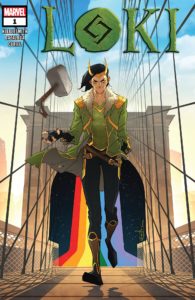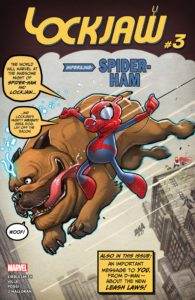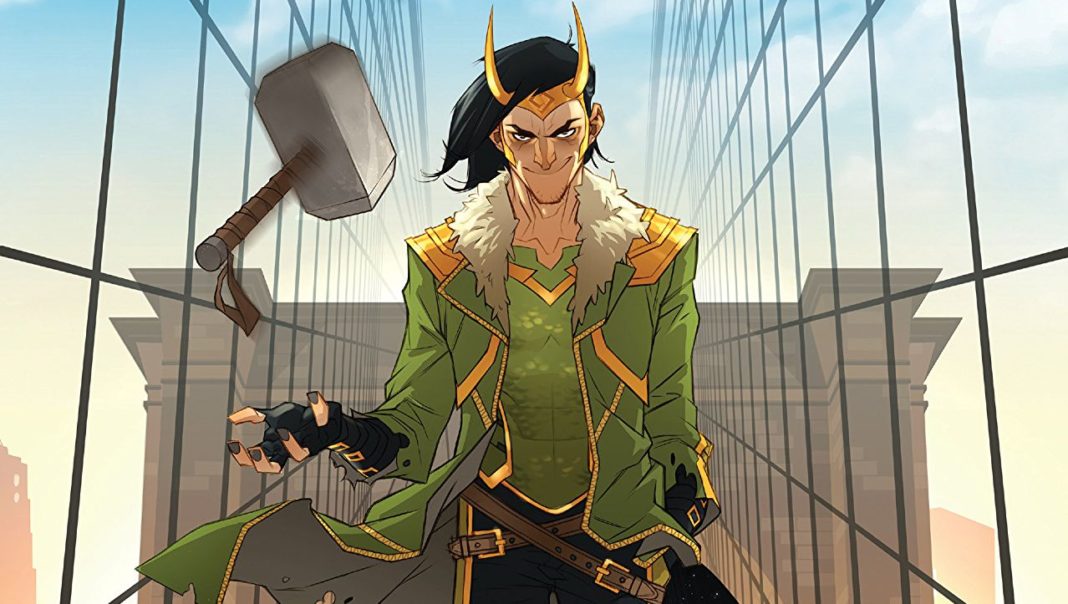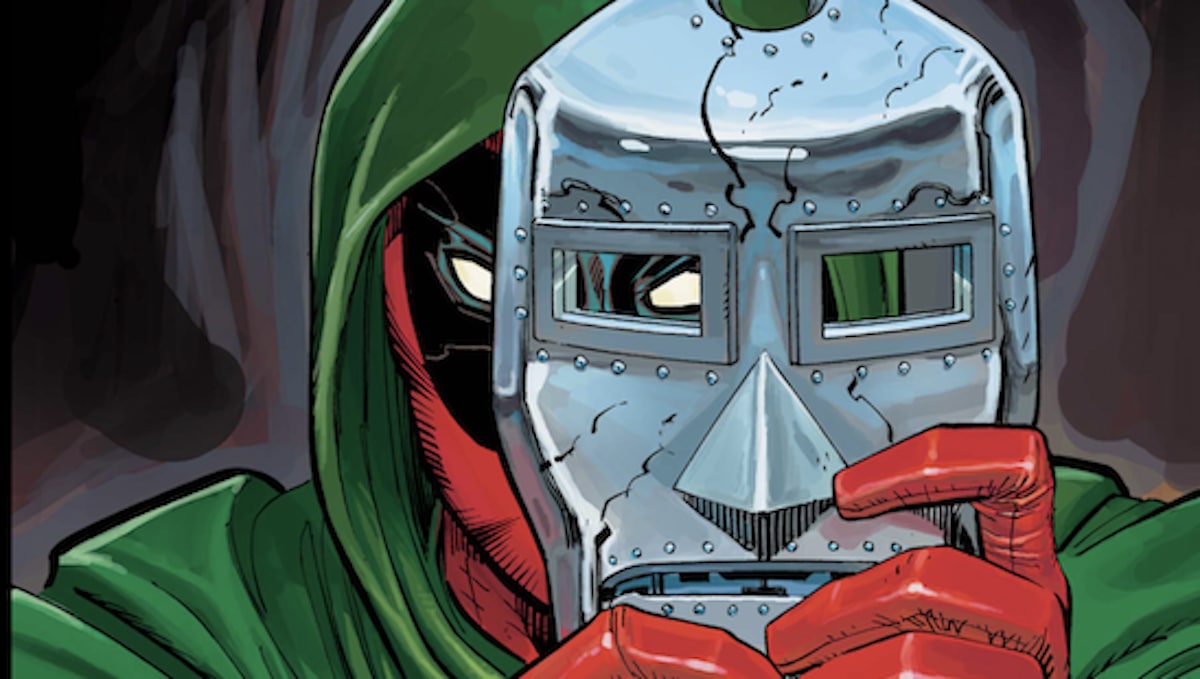By Gregory Paul Silber
It probably won’t surprise you to hear that Daniel Kibblesmith is as funny as you’d hope in person. He’s currently a staff writer for The Late Show with Stephen Colbert, and, among other humor-writing credits, a founding editor of ClickHole.
But throughout much of his work, including Marvel comics like Lockjaw, Black Panther vs Deadpool, and his new Loki ongoing series, it’s clear that he has more on his mind than the next punchline. Santa’s Husband, for example, may have started as a joke, but with help from illustrator Ashley Quach (now set to collaborate with Kibblesmith again on Princess Dinosaur), it transformed into an earnest, if still humorous, book for young kids that could be found in the picture book aisle rather than the humor section.
I sat down with Daniel Kibblesmith at his table in New York Comic Con’s Artist Alley to discuss the nuances of the various media he writes, telling Loki stories at the inexplicable height of the Norse god’s popularity, and more.
Gregory Paul Silber: Let’s get into the similarities between comedy writing and comic book writing. I don’t know quite as much about the ins and outs of writing for a late night show, but it’s a collaborative process. Comic book writing, unless you’re doing it all yourself, is a collaboration as well. Did comedy writing prepare you at all for comic book writing? Or did they feed into each other in any way?
Daniel Kibblesmith: I feel like they must… but to be honest, people ask me the difference all the time and people rarely ask me the similarity. And now I feel like I’ve been hit by lightning.
Silber: [Laughs] Oh, I’m sorry!
Kibblesmith: I think, certainly, whatever I’m doing flexes muscles and informs what else I’m doing, but… I will say that the obvious thing that they have in common is that, like you were saying, they’re collaborative. And right now, the only work I do is collaborative. I do children’s books with an illustrator, I do comic books with art and editorial teams, and I write for a television program… Other than translating scripts into a visual medium, that is, you know, the obvious comparison, is the succinctness that is necessary.

Certainly in monologue-style joke writing, something that has to fit inside of a weird balloon. So with Loki in particular, I love being very verbose. Giving him lots of little asides and stuff. And that’s something I enjoy in general. But when you’re writing for a panel of comic books, it is very important to be as economical with the words as possible. You know, literally bolds some of the important words in case people are reading quickly.
And that is comparable, I think, to writing monologue jokes in that certain words are bolded, so to speak, with inflection. You want to end on a punchline. You don’t want your sentence to sort of fizzle out. So weirdly, the similarities are very granular in my mind, and very technical. But generally speaking, it’s pretty different. You know, narrative versus news-driven, reactive. But that’s the big overlap. Clarity and economy.
Silber: Is there any kind of compartmentalizing you feel like you have to do in terms of… not just writing for late night, but the somewhat older audience that Loki calls for, versus a children’s book? I know you have Princess Dinosaur coming out, for example, and of course Santa’s Husband. Is there any concern that there’s a little more adult-oriented jokes in a lot of things you do? Or is it just “writing is writing?”
Kibblesmith: Sort of in between? The way I think of it is, it’s less of a compartmentalization. You know, because I view so many different mediums and audiences and stuff, I think what I am trying to teach myself is to always have the audience in mind. So it’s less of a compartmentalization or a changing gears as much as… I think a lot about the contract with the audience. It’s a phrase I throw around a lot. And I think that you have to — while surprising people and giving them things that they don’t know they want — you do have to meet the expectation of whatever is on the cover. Or if it’s a TV show, what people tune in for.
So I think about who is reading it and what their reading level is. And in the case of Marvel, how do they most likely know the character? You know Loki, I would say two thirds of the people picking it up probably mostly experienced Loki mostly through movies. And then the remaining third probably through Jason Aaron comics, at the moment. And then there’s obviously a demographic of people who read old comic books. They read the Jack Kirby Thor, and Walt Simonson Thor. It’s a lot of synthesizing it all into your omni-take on the character. But definitely, if you looked at it like a pie chart, our Loki would be weighted towards the movie Loki. Because that’s what the reader needs from it. So it’s the same deal with a children’s book. It’s just like, “Who’s going to read this, and how does their brain work? Let’s give them something that fits.”
Silber: That segues nicely into another question I had about Loki, specifically. Even though he’s existed in some form or another for literally thousands of years—
Kibblesmith: Yeah, he’s a popular story!
Silber: Yes! And yet I think it’s safe to say he is more popular than ever. Which, as you’ve said in some other interviews, is kinda nuts.
Kibblesmith: Yeah.
Silber: People know specifically the Marvel version of Loki. So how much, if anything, do you find yourself doing to kind of give access points to readers who, like you said, are coming in primarily knowing him from the movies, and primarily seeing him as Tom Hiddleston?
Kibblesmith: I’m very conscious of it. Obviously, it helps that we’re starting with a new number one. You know, a new number one came out in July. And War of the Realms gave us a really interesting status quo for Loki. And then my take on the character is that Loki doesn’t do status quo. So our story is about him bucking the story that was assigned to him. It’s really easy to be a jumping on point, because our story is about him saying, “OK, the things that happened before? I don’t want to do those.” I’m giving myself a blank slate. So between it being number one and us being really conscious of it needing to be accessible, it’s kind of it’s kind of baked in.
And then, I think the trick is keeping the reader in mind. Like I have to think about if this was my first Loki comic. Maybe I had read some Thor, or maybe I knew about some of the Kid Loki stuff but I didn’t have all of it. I just tried to think of the version of me that is reading this. I’ve been different levels of caught up on comics in my life. You know, I’ve gone away and come back. They make it pretty easy. The medium has historically been something that gets really bogged down in continuity and can be impenetrable. I think in more recent years it’s become something where the new default is a lot of jumping on points, a lot of relaunches and number ones. Living within those are Easter eggs and callbacks that are very satisfying to the people who will get the references. So I’m embracing that model for the most part.
Silber: It’s funny you mention that, because I feel like, being a professional liar, Loki is sort of a storyteller. I kind of feel like a lot of time, superhero comics can be as impenetrable to newcomers as they can seem. But also, a lot of time if you just sort of throw yourself into it, you’ll have more fun than you think. I feel like Loki, of all characters, would be the one like, “OK, keep up!”
Kibblesmith: Yeah he’s really very mercurial. The whole point is that he’s not always telling the truth anyway. It’s on you. And that was something I really really loved about Journey Into Mystery and Agent of Asgard. It was often on the reader to sort of of go along with it in a way that was really really satisfying… you can do that kind of storytelling when you have mystical characters. You can do a lot of big reveals about what was was really happening the entire time. Hopefully we’re going to do a lot of those as well. It’s Loki, so we want there to be a lot of twists. We want there to be tricks and surprises. I think both are fun. I think that these days there’s some mandates to come up with stories that the people who are coming from the movies can jump on board with immediately, but obviously people love ultra-dense continuity, or the X-Men wouldn’t have been the biggest thing in the ’90s.
Silber: I think one of the best examples of what you’re talking about is the love I’m seeing for Drrf.
Kibblesmith: Oh yeah. Mostly from me! 90 percent of it.
Silber: Oh yeah! I mean, I would certainly hope—
Kibblesmith: Oh no I’m just teasing because I love Drrf so much. He’s new! He’s a new Marvel character. It is very important to me that I contribute supporting characters to the Marvel Universe. So far they’ve all been a bunch of weird, puppety monster creatures, you know?
@TaikaWaititi You can put Drrf in #Thor4 if you want to do that, he's a good baby. pic.twitter.com/sIm7Vx8UjO
— Daniel Kibblesmith (@kibblesmith) July 16, 2019
Silber: I’m a big fan of Lockjaw’s sister.
Kibblesmith: Doc Jaw!
Silber: Doc Jaw, yes!

Kibblesmith: Doc Jaw, yeah, she’s a Terrigen Mist-exposed dog who was raised in the Spider-Ham universe. So she’s a Spider-Ham-style character, but she’s from Earth 616. But because of the anthropomorphic fields — which I think is something that we made up — because of the anthropormorphic fields, that’s how animals get turned into into cartoon characters on the Spider-Ham planet. So we have Doc Jaw out there. Frösti, obviously, the snowman who is the right hand of Jotunheim. And we have Drrf, obviously, our little buddy. Our little sidekick.
Silber: I’m really fascinated by this comic as a take on the villain redemption story. Because I think a lot of those stories could be very psychological. Like, how can this individual forgive themselves, or find their path to heroism? And with Loki, I think he very sincerely — despite being a total liar all the time — does want to become a hero. But it’s more sociological. He meets Iron Man, of course he sees his brother, Thor, and all of them are like, “Okay, yeah, sure.” No one believes him! As they shouldn’t! Because he’s been terrible for thousands of years!
Kibblesmith: Yeah, very recently! I mean it’s certainly a villain redemption story because it’s Loki. But I’m not really… how do I put this… I don’t think about it. Because I don’t think he’s thinking about it! I don’t think he’s thinking about it. If Loki does something bad, and it was a while ago, and he’s done something good since, his feeling is, “I am good. I have always been good. Why are you still mad at me? I just did something good.” I think of him like a dirtbag ex-boyfriend.
You know, he’s the Marvel universe’s terrible roommate. It’s like, “Yeah, I set a fire. And then I put it out, and while I was putting it out a lot of the dishes got clean. You’re welcome!” So Loki’s redemptive path… internally, I think it’s very tortured. But he doesn’t allow those feelings to come to the surface very often because they are painful. And he is not here to be in pain and feel guilty. He is ready to move on to the next thing. And everybody else is being difficult.
Silber: [Laughs] Yeah, I think I feel like, he himself is so not used to doing anything decent. For the world, for other people. So he’s like, “Alright, I’m crushing it!”
Kibblesmith: Well in our story, what he largely is after is praise. So it feels good to do good. But he hasn’t totally put that together yet. In the meantime, he’s doing it because he got rewarded. So we’re playing with that, and the long term goal is to show, “What does it mean to be a hero if you’re not doing things for a heroic reason?”
Silber: Are there any other upcoming projects that you have going on that you can tease a little, or that you think provide any detail on?
Kibblesmith: Nothing that I know 100 percent is going to happen, so I would never say it out loud.
Silber: Not even Princess Dinosaur?
Kibblesmith: Oh yeah, Princess Dinosaur is the one. Yeah, Princess Dinosaur is a children’s book about a princess who is also a dinosaur. Or a dinosaur who is also a princess. Which is kind of the entire point. Like most toddlers, she is all of those things at once. A beautiful delicate princess who is also a destructive force of animal, of prehistoric fury. So that comes out in fall of 2020, from myself and the Santa’s Husband illustrator, Ashley Quach. So it’s our next collaboration.
Silber: I love what you’re saying about the destructive part of it. I don’t think you even had any art for it yet, but when you announced that your next children’s book would be called Princess Dinosaur, I immediately started thinking… well, first of all that’s a great title, but also—
Kibblesmith: [Laughs] Thank you!
Silber: But also, I went through a phase when I was around 7, 8 years old… I was in second grade and I was obsessed with Godzilla.
Kibblesmith: Of course!
Silber: I mean, to an unhealthy degree. I had a friend quietly complain to my mom, “Greg talks too much about Godzilla.” And my mom had to pull me aside and be like, “You have to stop talking about Godzilla.”
Kibblesmith: A little bit! Take little breaks.
Silber: But I realized something about that kind of thing, for little kids specifically. We all, especially at that age, like to just be totally destructive. Like building blocks! My favorite part was to knock them over.
Kibblesmith: Well you don’t know! Of course. It’s either impulsiveness, or it’s incidental. You know? You color on the walls because you feel the power of coloring on the walls. So our feeling was that there were a lot of parents who were trying to raise children, especially daughters, outside of stereotypical gender pressures. And what I found working at bookstores and libraries was that you could have a household that’s like, “My daughter wears overalls. We only buy her Lego and science kits and dump trucks. And somehow, she still decided that she’s a fairy princess.” It’s almost like a backlash to the backlash.
Rather than reduce kids to childhoods where you’re really aiming to have no stereotypical gender roles enter the play space, expect the inevitability of these things being enticing. Maybe you go to a friend’s house, or you go to a costume parade or something at school. And you see fairy princesses everywhere. And it’s fun! Fairy princesses are beautiful. They get to wear dresses and have wings. And a lot of little kids want to be those, even if their parents are trying very hard to keep everything neutral. It’s going to happen.
So our feeling, as with a lot of the writing I do of archetypes or existing characters, is that it’s about synthesis. It’s about accepting that little kids go through a lot of phases. They contain multitudes. They can rapidly oscillate between the two things. And when I think about the kind of like little girl that my wife was, and the kind of child that we are likely to have, it is a Princess. Dinosaur. Or a dinosaur princess. Yeah. It is somebody who will, in a tutu, throw a plate on the ground.
Silber: I think that’s such an insightful way I think about the way kids are. Just the way kids are. Even for me — nominally an adult — I find myself thinking, “I don’t know if I should like that thing. It’s so predictable that someone like me would like that thing.”
Kibblesmith: It’s very basic, to be a princess.
Silber: [Laughs] Yes! And I was like, “Okay well, you don’t have to fit into people’s expectations of you. But if you happen to naturally gravitate towards something that maybe, for your demographic, there’s an expectation that you’d like that sort of thing… that’s okay too!”
Kibblesmith: I think it lets parents off the hook as well. You’re not a failure if your kid likes princesses. You know? It’s in the water. It’s everywhere. The trick is just to make sure it’s part of a balanced cultural diet.
Silber: My biggest memory of that kind of thing you’re talking about, is I was playing with this Spider-Man laser tag set with my little sister when she was around 5, and I would’ve been 12. And she had the Spider-Man one, she had the Green Goblin one, and she was like, “This Spider-Man laser matches my dress!”
Kibblesmith: There you go. That’s all there is to it. You find something in the world that speaks to you, and you live it.
Princess Dinosaur hits shelves next year; Loki returns with issue #5 on November 20, 2019. To keep up with Daniel Kibblesmith on social media, follow him on Twitter @kibblesmith.








Comments are closed.